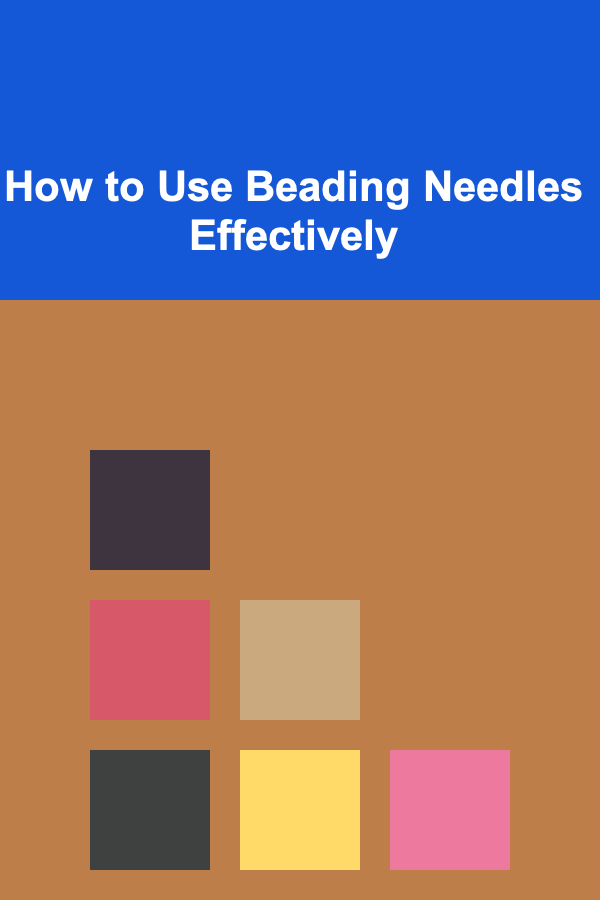
How to Use Beading Needles Effectively
ebook include PDF & Audio bundle (Micro Guide)
$12.99$5.99
Limited Time Offer! Order within the next:

Beading is a versatile craft that involves the use of beads to create intricate jewelry, accessories, and decorations. One of the essential tools for any beading project is the beading needle. These needles come in various sizes and types, each designed to suit different materials and techniques. Knowing how to use beading needles effectively can make a significant difference in the quality of your work and the efficiency with which you complete your projects.
In this article, we'll explore how to choose the right beading needle for your needs, how to thread it properly, and how to use it effectively for various beading techniques. Whether you're a beginner or an experienced beader, these tips and tricks will help you improve your skills and make your beading projects more enjoyable and professional-looking.
Understanding Beading Needles
Before you start, it's important to understand the different types of beading needles available and when to use each one. Beading needles are typically longer and thinner than regular sewing needles, allowing them to fit easily through small beads without causing damage.
Types of Beading Needles
- Standard Beading Needles: These are the most common type of beading needle, used for a variety of bead sizes and threading materials. They are often flexible and come in different lengths, allowing for better control when working on intricate designs.
- Sharp Needles: These needles are designed with a very fine tip that allows them to pass through small holes in delicate beads, such as seed beads or gemstones. They are great for detailed beadwork.
- Tapestry Needles: These needles have a larger, blunt tip and a wide eye, making them perfect for using with thicker threads and large beads. Tapestry needles are often used for beading projects that require a thicker thread, such as embroidery.
- Double-Ended Needles: These needles have two eyes, one at each end, allowing you to thread both ends with different colors or threads for more complex beading designs. These are particularly useful in projects that involve multiple thread passes through the same bead.
- Specialty Needles: For very specific projects, you might encounter specialty beading needles, such as curved needles for weaving or needles that have been coated with a special finish to make them glide through beads more easily.
Needle Sizes
Beading needles come in various sizes, which are denoted by numbers (e.g., 10, 12, or 15). A smaller number indicates a thicker needle, while a larger number indicates a finer needle. The size you choose depends on the type of beads you're working with:
- Size 10-12: Best for larger beads like 6/0 or 8/0 seed beads.
- Size 13-15: Suitable for smaller beads like 11/0 or 15/0 seed beads.
- Size 18: Ideal for very tiny beads such as 15/0 or 16/0 seed beads.
How to Thread a Beading Needle
Threading a beading needle can sometimes be tricky, especially when working with fine needles or small bead holes. However, with a few simple techniques, you can easily get your needle ready for use.
Step-by-Step Guide to Threading a Beading Needle
- Cut Your Thread: Start by cutting a piece of beading thread to the desired length. It's a good idea to cut the thread a little longer than you think you'll need, as you can always trim it later.
- Choose the Right Thread: Choose a beading thread that is appropriate for your project. Nylon thread, silk thread, and fireline are all common choices for beadwork. Fireline, for example, is a very strong, braided thread that works well for projects that require durability.
- Thread the Needle: Hold the thread between your fingers and pass it through the eye of the beading needle. Be sure to pull the thread through until you have an equal length on both sides.
- Secure the Thread: Once the needle is threaded, tie a small knot at the end of the thread to prevent it from slipping out while you work. This knot will act as a stopper when you add your beads.
Tips for Threading Success
- Use a Needle Threader: If you find it difficult to thread the needle, especially with fine needles, a needle threader can help. This small tool creates a loop of thread that you can easily pass through the eye of the needle.
- Moisten the Thread: Moisten the end of your thread with a little water or a beeswax thread conditioner to make it more rigid and easier to thread through the needle.
Basic Beading Techniques
Once your needle is threaded, you're ready to start beading. There are several basic beading techniques you can use, depending on the style and design of your project. Here are a few techniques where beading needles play a crucial role.
Stringing Beads
One of the simplest ways to use a beading needle is for stringing beads. This technique involves threading the beads onto a thread, which can then be tied off to create a bracelet, necklace, or other beaded piece.
- Tip: Use a beading needle to pass through small beads easily and ensure that the beads are strung neatly on the thread. The flexibility of the needle allows it to move easily through the beads without fraying or damaging the thread.
Loom Beading
Loom beading is a more intricate technique where beads are woven together on a loom to create detailed patterns. Beading needles are used in loom weaving to thread the beads onto the loom's warp threads and to weave in and out of the beads.
- Tip: For loom beading, a double-ended needle is often preferred. This allows you to work more efficiently and complete each row of beads in one pass.
Peyote Stitch
Peyote stitch is a popular beading stitch used to create a flat or tubular pattern by weaving beads together. It requires passing the needle through multiple beads in a specific pattern to form the stitch.
- Tip: Use a sharp, flexible beading needle when working with peyote stitch. The needle needs to be thin enough to pass through the beads multiple times without causing them to break or become misshapen.
Right-Angle Weave (RAW)
Right-angle weave is a bead weaving technique where you connect beads at right angles to each other, creating intricate patterns and structures. Beading needles are used to thread beads through the existing beadwork, allowing you to build up layers of beads to form complex designs.
- Tip: A flexible, sharp beading needle is essential for working with RAW, as the technique often requires passing the needle through beads multiple times to secure the design.
Advanced Beading Techniques
Once you're comfortable with basic techniques, you can move on to more advanced beading methods. These methods often involve more intricate stitching, multiple thread passes, and additional tools like bead caps, spacers, and clasps.
Bead Embroidery
Bead embroidery involves stitching beads onto fabric to create textured designs and patterns. Beading needles are used to pass through the fabric and the beads, attaching them securely in place.
- Tip: Use a larger, blunt-tipped needle for bead embroidery, as it will work more easily with fabric. Tapestry needles are ideal for this purpose, as they have wide eyes that can accommodate thicker embroidery threads.
Bead Crochet
Bead crochet involves stringing beads onto thread and then crocheting them into a chain. Beading needles are used to add beads to the thread as you crochet, creating intricate, bead-laden chains and designs.
- Tip: A thinner beading needle is ideal for bead crochet, as it will allow the beads to pass through smoothly as you crochet.
Circular Brick Stitch
Circular brick stitch involves stacking beads in a circular fashion to create intricate shapes, such as flowers or rosettes. This technique requires precise control over the thread and beads, which is where beading needles come in.
- Tip: For circular brick stitch, use a fine, flexible beading needle to allow easy maneuvering through the beads as you complete each stitch.
Maintenance and Care of Beading Needles
To ensure that your beading needles remain in good condition and provide smooth, efficient stitching, it's important to take proper care of them.
Storing Needles
Keep your beading needles in a safe, organized place to prevent them from bending or becoming damaged. Needle storage cases or small, labeled compartments work well for this purpose.
Cleaning Needles
If your needles become clogged with thread or bead residue, you can clean them by gently wiping them with a soft cloth. For more stubborn dirt, use a tiny brush to scrub away debris.
Replacing Needles
Beading needles, especially those made of fine wire, can become bent or dull with repeated use. If you notice any damage or difficulty threading the needle, it's time to replace it.
Conclusion
Beading needles are essential tools for any beading project, from simple stringing to advanced bead weaving techniques. By understanding the types of needles available, learning how to thread them effectively, and mastering various beading techniques, you can elevate your beadwork to new levels of creativity and professionalism. With patience, practice, and the right tools, you'll be able to create beautiful, intricate designs that showcase your craftsmanship.
Reading More From Our Other Websites
- [Home Storage Solution 101] How to Store Your Fitness Equipment in a Way That Saves Space
- [Home Budget Decorating 101] How to Mix High and Low-End Decor Pieces to Save Money
- [Sewing Tip 101] Best Eco‑Friendly Fabrics for Sustainable Sewing Projects
- [Personal Care Tips 101] How to Use Aftershave for a Smooth and Irritation-Free Shave
- [Horseback Riding Tip 101] Ride More, Spend Less: Budget‑Friendly Trail Riding Destinations
- [Personal Care Tips 101] How to Choose the Right Toothbrush for Your Oral Health Routine
- [Home Lighting 101] How to Choose the Best Lighting for Your Home's Interior Design Style
- [Organization Tip 101] How to Avoid Multitasking and Improve Focus
- [Scrapbooking Tip 101] Seasonal Stories: How to Craft Themed Scrapbook Spreads for Every Holiday
- [Ziplining Tip 101] Best Zipline Tours in Costa Rica: Rainforest Adventures & Wildlife

How to Clean Your Ceiling Fans and Light Fixtures
Read More
How to Create a Multi-Purpose Fishing Setup
Read More
How to Foster Good Organization Habits in Children
Read More
How to Make Your Home Shine with Holiday Lights and Lanterns
Read More
How to Use Time Blocking to Manage Your Day
Read More
How To Create Engaging Learning Activities for All Ages
Read MoreOther Products

How to Clean Your Ceiling Fans and Light Fixtures
Read More
How to Create a Multi-Purpose Fishing Setup
Read More
How to Foster Good Organization Habits in Children
Read More
How to Make Your Home Shine with Holiday Lights and Lanterns
Read More
How to Use Time Blocking to Manage Your Day
Read More